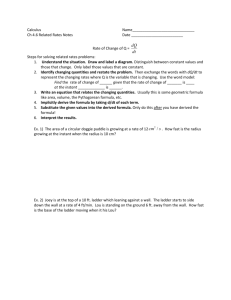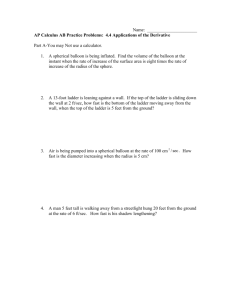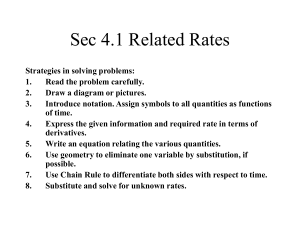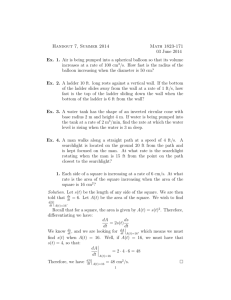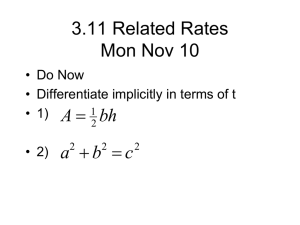Section 2.6 - jpiichsabcalculus
advertisement
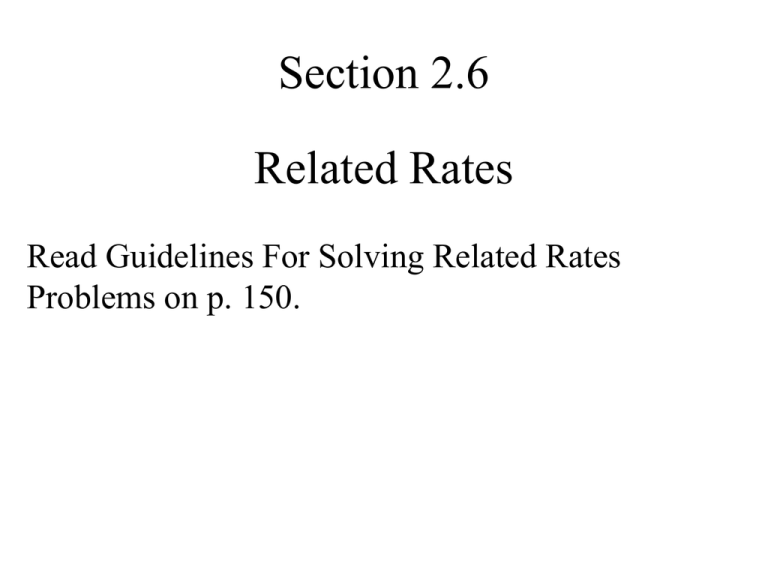
Section 2.6 Related Rates Read Guidelines For Solving Related Rates Problems on p. 150. Example 1 A 17 foot ladder is sliding down a wall. The base of the ladder is moving away from the wall at a rate of 2 feet per second. How fast is the top of the ladder moving down the wall when the base of the ladder is 8 feet away from the wall? Step 1: Draw a sketch and label known and unknown quantities. Write down what is given and what is to be determined. s = 17 ft. y x dx Given: 2 ft/s dt dy Find: when x 8 dt Step 2: Write an equation involving the variables whose rates of changes either are given or to be determined. x 2 y 2 17 2 Step 3: Differentiate each side with respect to t. d 2 d 2 x y 289 dt dt dx dy 2x 2 y 0 dt dt Step 4: Substitute all known values for the variables and their rates of change. Then solve for the required rate of change. x 2 y 2 17 2 x 8 so y 15 dy 2 8 2 2 15 0 dt dy 16 1.067 ft/s dt 15 The top of the ladder is moving down the wall at a rate of about −1.067 ft/s when the base of the ladder is 8 ft. from the wall. Example 2 An adventurer rides down a zip-line at a speed of 80 mph. If the angle of depression of the zipline is 75°, how fast is the zip-liner’s altitude changing? dz Given: 80 mph 75° dt z h dh Find: dt 75° z h The adventurer’s altitude is decreasing by a rate of about 77.274 mph when the angle of depression is 75°. h sin 75 z z sin 75 h dh dz sin 75 dt dt dh sin 75 80 dt dh 77.274 mph dt Example 3 A 6 foot tall man walks away from a 22 foot street light at a speed of 8 feet per second. What is the rate of change of the length of his shadow when he is 19 feet away from the light? Also, at what rate is the tip of his shadow moving? 22 6 x s dx Given: 8 ft/s dt ds a Find: when x 19 dt 6 s 3 s 22 x s 11 x s 3 x 3s 11s 3 x 8s 3 s x 8 22 6 x s The length of the man’s shadow is increasing at a rate of 3 ft/s. 3 s 11 x s 3 x 3s 11s 3 x 8s 3 s x 8 ds 3 dx dt 8 dt ds 3 8 3 ft/s dt 8 dx ds Given: 8 ft/s and 3 ft/s dt dt 22 6 dy b Find: when x 19 x s dt y=x+s dy dx ds dt dt dt 8 3 11 The tip of his shadow is moving at rate of 11 ft/s when he is 19 ft. from the street light. Example 4 A large spherical balloon is being inflated and its volume is increasing at a rate of 3.5 cubic feet per minute. What is the rate of change of the radius when the radius is 7 feet? r dV Given: 3.5 cu. ft. per min. dt dr Find: when r 7 feet dt r 4 3 V r 3 dV 4 2 dr 2 dr 3 r 4r dt 3 dt dt dr 3.5 4 7 dt dr 3.5 2 dt 4 7 2 The radius of the spherical balloon is increasing at a rate of about 0.006 ft/sec when the radius is 7 ft. dr 0.006 ft/min dt Example 5 An upside-down conical tank full of water has a “base” radius of 3 meters and a height of 5 meters. The is being drained at a rate of 2 cubic meters per meter. What is the rate of change of the height of the water when the height is 4 meters? 3 r h dV Given: 2 cu. meters per min dt 5 dh Find: when h 4 dt 3 r 5 h 3 r 5 h r h 3 5 3 r h 5 1 2 V r h 3 2 1 3 V h h 3 5 3 3 V h 25 3 3 3 V h 25 r h 5 dV 3 2 dh 3 h dt 25 dt 9 dh 2 16 25 dt dh 0.111 meters/min dt The height of the water is decreasing at a rate of about 0.111 meter/min when its height is 4 meters. The Grand Finale!!!! Example 6 An upside-down conical tank full of water has a “base” radius of 5 feet and a height of 7 feet. The water is being drained into a cylindrical tank with radius of 5 feet and height 6 feet. The radius of the water in the conical tank is decreasing at a rate of 2 feet per minute. At what rate does the water level in the cylindrical tank rise when the water level in the conical tank is 3 feet? 5 dr Given: 2 ft/min dt r 7 h1 dh2 Find: when h1 3 ft dt 5 5 h2 6 5 r 7 h1 5 5 h2 1 2 2 Vcone r h1 and Vcyl r h2 3 5 h1 r r 7 7 5 h1 7 h1 r 1 27 5 6 Vcone r r 3 5 7 3 Vcone r 15 2 Vcyl 5 h2 25h2 5 Vcone r 7 h1 5 5 h2 6 7 3 r and Vcyl 25h2 15 dVcone 7 2 dr 3 r dt 15 dt dVcone 7 2 14 2 r 2 r dt 5 5 dVcyl dh2 25 dt dt dVcyl dVcone dt dt 5 dVcyl r 7 h1 5 5 h2 6 dVcone dt dt 7 h1 r 5 7 14 2 3 r r 5 5 7 r 15 2 dh2 14 15 dh2 0.514 ft/min 25 5 7 dt dt The water level in the cylindrical tank is increasing at rate of about 0.514 ft./min when the water level of the conical tank is 3 ft.
